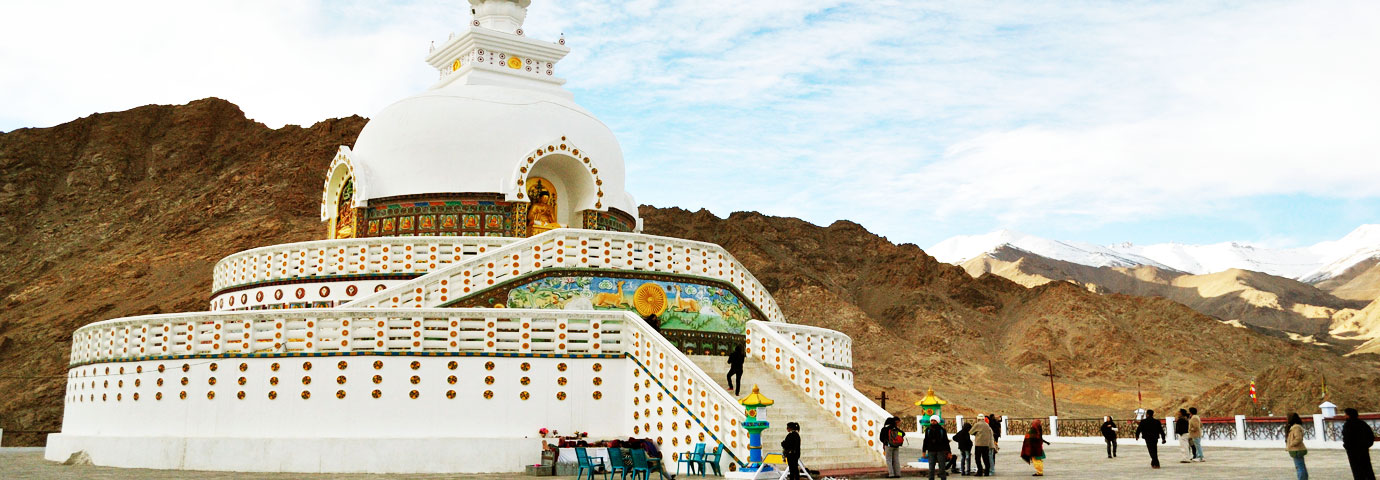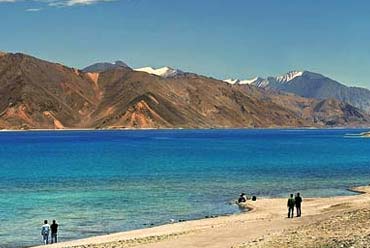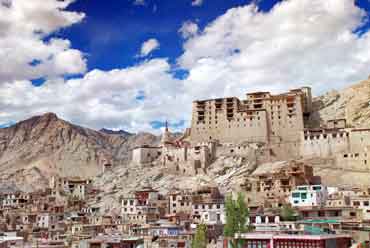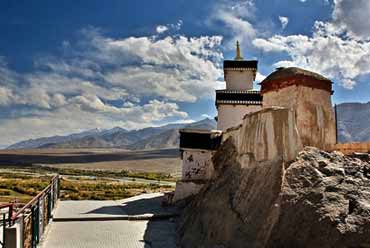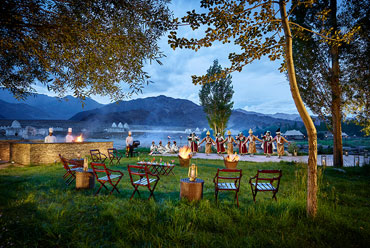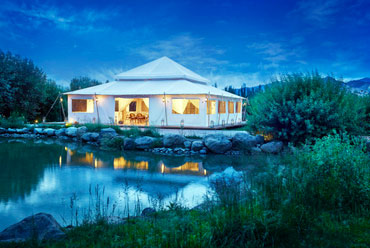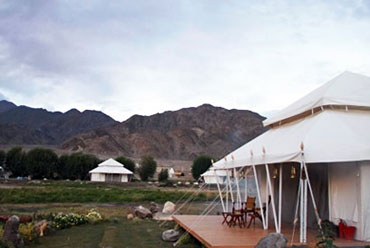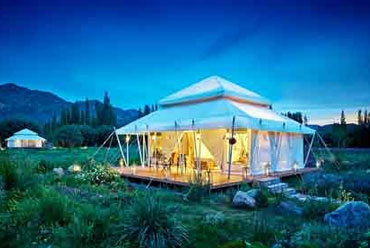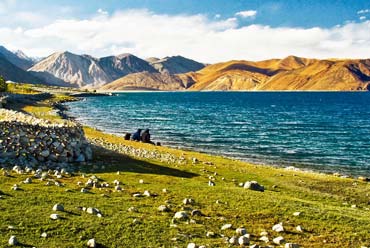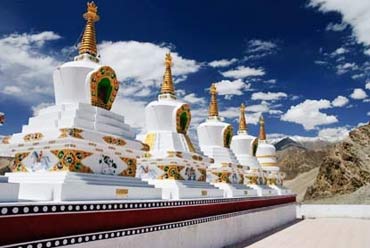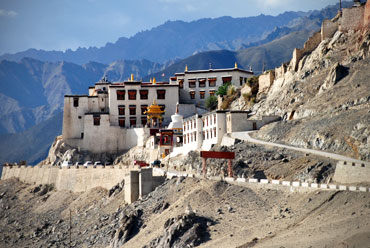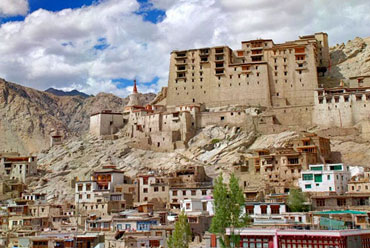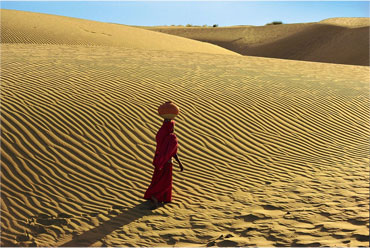Tourist Attractions in Leh
A miniature version of the Potala in Lhasa, the Leh Palace is one of the major attractions here. The palace was built in the 17th century and is now dilapidated and deserted. It was the home of the royal family until they were exiled to Stok in the 1830s. Above the palace, at the top of the Namgyal hill, is the Victory Tower, built to commemorate Ladakh's victory over the Balti Kashmir armies in the early 16th century.
The Namgyal Tsemo Gompa, built in 1430, contains a three-story high Buddha image and ancient manuscripts and frescoes. The fort above this gompa is ruined, but the views of Leh from here are breathtakingly beautiful.
The Sankar gompa is located a couple of kilometers north of the town center. The gompa belongs to the Gelukpa order and has an impressive impression of the Buddhist deity Avalokiteshwara Padmahari or Chenresig, with 1,000 arms and an equal number of heads.
The Shanti Stupa was built by a Japanese order and was opened by the Dalai Lama in 1985. From the top, one can view the exotic locales nearby. The stupa is located at a distance of 3 km from the Fort Road.
The Mughal emperor Aurangzeb commissioned the mosque at the head of the Leh Bazaar. The Soma gompa lies near the mosque.
Places Around Leh India
Seventy kilometers from Leh India, on the banks of river Indus, is the Alchi gompa dating back to the 11th century. It is one of the largest and a famous monastery with a widely renowned collection of paintings.
At a distance of 45 km south of Leh, Hemis is one of the biggest gompas in Ladakh. Built in 1630, it belongs to the red sect, Brokpa. It is also known as Chang Chub Sam Ling or "the lone place of the compassionate person." To commemorate the birth of the renowned Indian sage, Padmasambhava, the annual Hemis festival is held in the month of June/July.
Situated on the opposite bank of the Indus across Thikse, the Matho gompa was established in the first half of the 16th century and has a valuable collection of old and beautiful thangkas, some in the form of 'mandalas.' Its annual festival of oracles in early March is an important event in the Ladakhi religious calendar.
Until the 16th century, the Shey gompa was the royal residence. It is located at a distance of 15 km south of Leh. This Palace Monastery has the largest statue of Maitreya Buddha (the Buddha to come) in Ladakh. Erected in the mid-17th century, worked out of gold and gilded copper sheets with blue hair, it stands 17.5 m high.
At a distance of 8 km from Leh, standing majestically on top of a hillock overlooking the Indus Valley, lies the Spituk Gompa. It was built in the 15th century and houses a collection of ancient masks, antique arms, icons and thangkas. Higher up the hill is the Mahakal Temple, containing the shrine of Vajrabhairava.
About 20 km south of Leh, Thikse gompa is an imposing monastery and one of the finest examples of Ladakhi architecture. It belongs to the Gelukpa order. The 12-story monastery complex contains numerous stupas, statues, thangkas, wall paintings, swords and a large pillar engraved with the Buddha's teachings.
Belonging to the Brokpa sect, the Phyang gompa was built in the 16th century. Located at a distance of 16 km from Leh, it houses hundreds of statues, thangkas, old manuscripts and some old weapons.
The Bagso gompa is located 40 km downstream from Leh, and was the seat of power of a branch of the Namgyal family. It is here in AD 1680 that invading Mongol and Tibetan armies were held in check over a three-year-long siege. Original 16th-century murals and other arts of Bagso are worth seeing.
About 45 km from Leh, the Chernry gompa is situated in a picturesque valley leading to Changia. It was constructed upon Sengge Namgyal's death in 1645. A large collection of scriptures with title pages in sterling silver and the text in gold letters is kept here.
Precariously perched atop a 200-meter-high crag, the Mulbekh gompa has an imposing rock carving of the future Buddha. On the other end of the valley is a phallus-shaped rock with a monastery at its base.
At a distance of 50 km east of Leh, the Thak Thog gompa is the only monastery belonging to the Nying-ma-pa order. Gum Rinpoche (Padma Sambhava) is said to have founded this monastery and the temple where he meditated is still to be seen here. Tu-Phuk houses the images of Guru-Tsan-gyet (eight forms of Padma Sambhava), Guru Takpo Tsahl and the 11-headed Avalokitesvara. The new monastery is built on ground level and contains the image of Guru Nang Srith Zilon in a central position. To its right is an image of Guru Dorje Dolo and on the left is an image of Guru Padma Gyalpo. There are seats for the Dalai Lama and Taklung Rinpoche (the incarnate Lama of the monastery). The monastery stages two festivals every year. Thak Thog Tse Chu is held from the ninth to the eleventh day of the sixth Tibetan month. Thak Thog Wangchogis is held from the 26th to the 29th day of the ninth Tibetan lunar month.
Near Leh, the town of Choglamsar is an important center for Tibetan Buddhism and the study of Tibetan study and culture. One can find here a Tibetan library, medical center, handicraft shops, study center, bookshops, plenty of restaurants and the Central Institute of Buddhist Studies.

